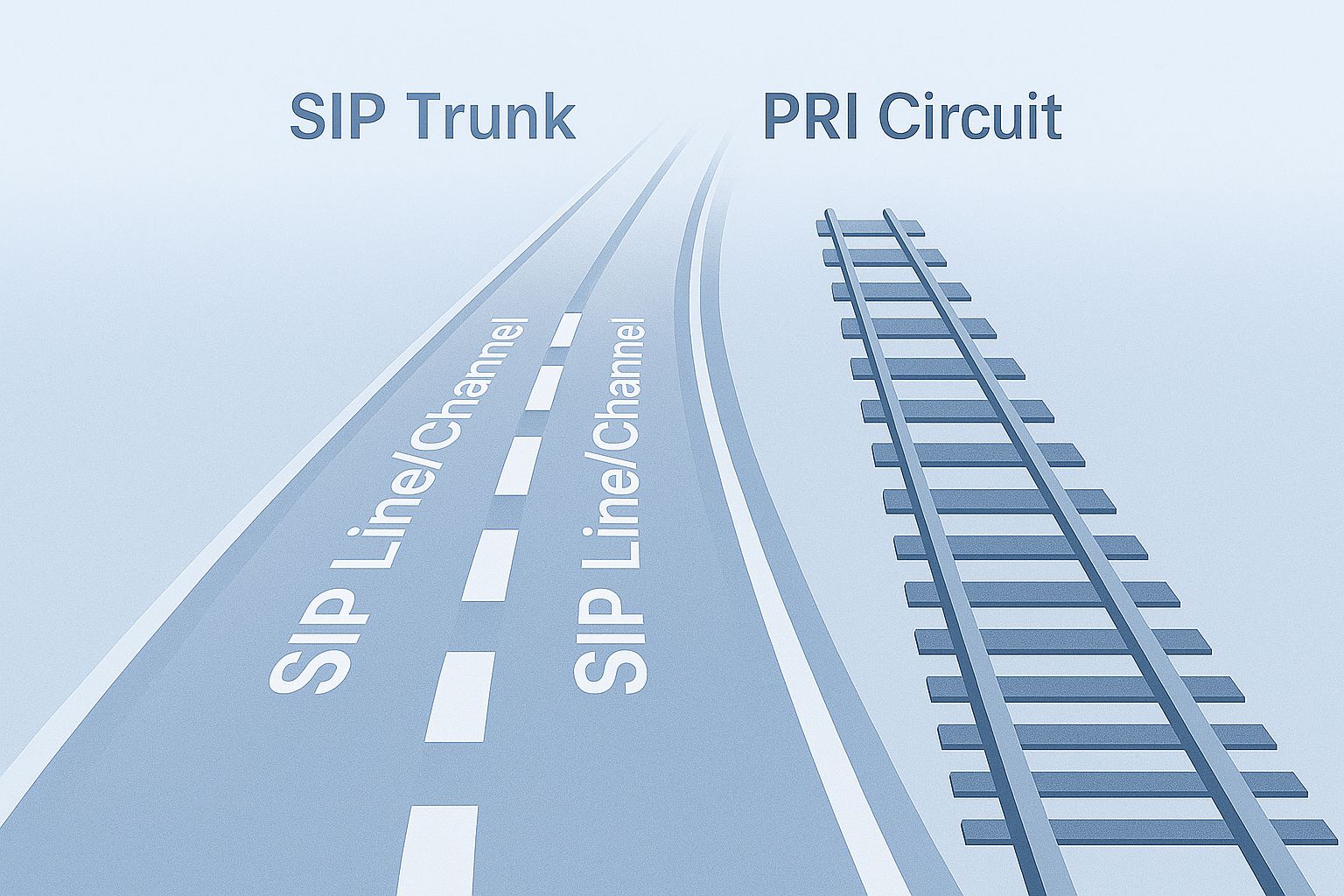Imagine we’re chatting over coffee…
You lean in and ask, “My telco rep keeps pushing _SIP lines._ Are they different from VoIP? From trunks? And why does the bill look like a phone number sudoku?”
Great questions. Let’s break them down the same way I’d explain them to my cousin who runs a 20-seat call center straight talk, plenty of real examples, and no alphabet-soup techno-babble.
Why the term “SIP line” exists in the first place
Traditional phone companies sold physical lines pairs of copper that carried exactly one call at a time.
When calling moved onto the internet, engineers used Session Initiation Protocol (SIP) to set up and tear down those calls digitally. Each SIP channel now acts like a single “lane” on the voice highway. Many people started calling each lane a SIP line because it felt familiar.
Think of it as the digital twin of the old copper line, just faster, cheaper, and infinitely more flexible.
Untangling SIP Line, SIP Trunk, VoIP, and PRI: Where Each Fits in Your Stack
The trunk-and-branch analogy
- A SIP trunk is the whole highway.
- A SIP line/channel is one lane on that highway.* VoIP is simply the technology riding on those lanes, while PRI is yesterday’s four-lane toll road made of expensive T1 circuits. Functionally, a business with 10 simultaneous calls needs 10 SIP lines (channels) inside one trunk; the distinction is mostly billing and provisioning.

What a SIP Line Really Costs: Crunching the Numbers Without the Jargon
1. Per-channel subscription
Industry averages range $12–$25 per channel/month depending on volume.
2. Usage or unlimited minutes
Some providers bundle free domestic minutes, others bill per-minute after a threshold.
3. Mandatory surcharges
E911 fees, telecom taxes, universal service funds small line items that add up.
4. Setup & porting
Many providers waive setup today, but number porting (~$15 per DID) still appears on invoices.
Reality check: A 25-seat support team averaging eight concurrent calls might see a monthly voice line bill of ≈ $240 (20 channels × $12) plus taxes often 45-60 % cheaper than the old PRI bundle.
Calculating the Exact Number of SIP Lines Your Team Will Need
Use this back-of-napkin formula:
Peak concurrent calls × 1.1 (headroom) = Channels required
If your analytics show 15 calls at peak, budget for 17 channels. Overbuying “just in case” locks money in unused capacity; under-buying chokes customer experience. Many providers let you burst extra channels on demand, so start lean and scale.
The five step deployment playbook You Can Steal
Step 1 – Audit your current traffic
Pull CDRs or PBX logs for a normal busy week. Identify simultaneous call peaks, toll-free volume, and international destinations.
Step 2 – Check network readiness
100 Kbps per concurrent call is a safe rule. Prioritize voice with QoS tagging; jitter and 1 % packet loss ruin HD audio.
Step 3 – Pick your architecture
- On-prem PBX + SIP trunk if you already own hardware.
- Hosted PBX if you’d rather off-load maintenance.
- Softphones for remote teams just laptops and headsets.
Step 4 – Port numbers & provision E911
Submit an LOA (letter of agency) to port your DIDs. Typical timeline: 7–14 business days. Provide correct civic address for every outbound caller ID; the FCC mandates accurate Enhanced 911 location data for VoIP.
Step 5 – Cut-over & monitor
Stage the migration after business hours, forward PRI to SIP trunk as a safety net, and watch MOS (mean opinion score) on day one.
Real World Case Study: How an HVAC Firm Slashed Monthly Telephony Spend by 60 %
Company: Regional HVAC outfit with 30 field technicians.
Old setup: Two PRI circuits (46 channels) at ~$1,200/month.
Shift: Migrated to 25 SIP lines; kept existing local numbers.
Outcome: Monthly cost dropped to $375, HD call quality, dispatchers gained presence detection in softphones.
The Most Common Pitfalls and How to Dodge Them Like a Pro
| Mistake | Why it hurts | How to avoid |
|---|---|---|
| Buying “unlimited” everything | Hidden fair-use caps throttle you mid-month | Model real usage and compare tiered vs. unlimited |
| Ignoring fail-over | ISP outage = dead phone lines | Add LTE/5G backup or a second ISP |
| Skipping QoS | Voice battles Netflix traffic | Prioritize SIP ports in router |
| Forgetting 911 address updates | Non-compliance fines & safety risk | Automate address sync in PBX |
The road ahead SIP and Next-Gen 911
The FCC’s roadmap pushes Next Generation 911 services that carry not only voice but also text, precise GPS, and even video to responders. Because SIP underpins those multimedia sessions, businesses on SIP lines today are already future-proofing for richer emergency communications mandates rolling out over the next decade.
FAQs
1. What is a SIP phone line in plain English?
A digital pathway that lets one phone call travel over your internet instead of a copper wire.
2. Is a SIP line the same as VoIP?
VoIP is the technology, SIP is the protocol enabling it. A SIP line is simply one concurrent VoIP call path.
3. How long does number porting take?
Anywhere from 3–14 business days, depending on your current carrier’s response time.
4. Can I keep PRI for backup while testing SIP?
Yes run dual-homed routing or forward the PRI to your new SIP DIDs during pilot.
5. Will SIP lines handle 911 properly?
Absolutely, as long as you register each caller ID’s physical address with your provider (E911).
Conclusion
If you’re exploring SIP lines because call volume keeps climbing, chances are your team could also use an AI voice agent to field routine inquiries. SuperU spins up a friendly, 24/7 voice assistant that sits on top of your new SIP setup no extra hardware, just happier callers and lighter workloads.
Curious? Grab a five minute demo and see how SIP lines + SuperU’s voice agent turn every ring into revenue.
Start for Free – Create Your First Voice Agent in Minutes


